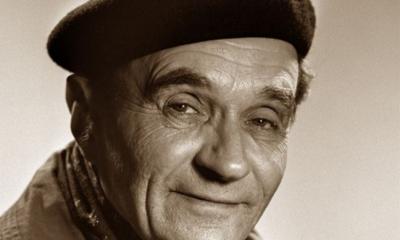History and present
The station is located at an altitude of 2835 above sea level, on a glacier, which nearby reaches a maximum thickness of 2850 m (). The average annual temperature is about -49 ° С; varies from −28 °C in December to −60 °C in July. Average wind speed - 5.5 m / s; gusts up to 27 m/s were recorded.
Station foundation (1957-1975)
The original station is now called the "Old Pole" (Eng. old field) - was founded in 1956-1957. an 18-man US Navy expedition that landed here in October 1956 and wintered there for the first time in 1957. Since climatic conditions were not previously known, the base was built underground to overcome any worst weather conditions. The lowest temperature in 1957 was recorded at −74 °C (−102 °F). Survival in such a low temperature, combined with low humidity and low air pressure, is only possible with proper protection.
The station, abandoned in 1975, is covered with snow (like any structure at the South Pole) at a rate of 60-80 mm per year. Now it is buried deep enough and is completely closed to the public, as snow has crushed all the wooden floors.
On January 4, 1958, the British Commonwealth Transantarctic Expedition arrived at the station with renowned mountaineer Edmund Hillary. It was the first expedition to use road transport and the first to reach the Pole by land since Amundsen in 1911 and Scott in 1912. The expedition moved from the New Zealand station Scott Base.
Dome (1975-2003)

An aerial photograph of Amundsen - Scott Station taken circa 1983. The central dome is visible, as well as various containers and ancillary buildings.

The main entrance to the dome is located below the snow level. Initially, the dome was built on the surface, but then gradually sank into the snow.
The aluminum unheated "tent" is the pole's landmark. It even had a post office, a shop and a pub.
Any building at the pole is quickly surrounded by snow and the design of the dome was not the best. A gigantic amount of fuel was used to remove the snow, and shipping a liter of fuel costs $7.
The 1975 equipment is completely outdated.
New scientific complex (since 2003)
The unique design on piles allows snow not to accumulate near the building, but to pass under it. The sloping shape of the lower part of the building allows the wind to be directed under the building, which contributes to the blowing of snow. But sooner or later the snow will cover the piles and then it will be possible to raise the station twice with jacks (this increases the service life of the station from 30 to 45 years).
Building materials were delivered by Hercules aircraft from McMurdo station on the coast and only during daylight hours. More than 1000 flights have been made.
The complex has:
- 11 km low-frequency antenna for observing and predicting celestial and space storms,
- the highest pole at the pole 10-meter telescope, climbed 7 floors up and weighing 275 thousand kg
- drilling rig (depth - up to 2.5 km) for the study of neutrinos.
On January 15, 2008, in the presence of the leadership of the US National Science Foundation and other organizations, the American flag was lowered from the dome station and raised in front of a new modern complex. The station can accommodate up to 150 people in summer and about 50 in winter.
Activity
In summer, the population of the station is usually more than 200 people. Most of the staff leave by mid-February, leaving only a few dozen people (43 in 2009) wintering, mostly support staff plus a few scientists who run the station during the months of Antarctic night. Winterers are isolated from the rest of the world from mid-February to late October, at which time they face many dangers and stresses. The station is completely self-sufficient in winter, powered by three generators running on JP-8 aviation fuel.
Research at the station includes sciences such as glaciology, geophysics, meteorology, upper atmospheric physics, astronomy, astrophysics, and biomedical research. Most scientists work in low frequency astronomy; the low temperature and low humidity of the polar air, combined with the altitude of over 2,743 m (9,000 ft), causes the air to be much more transparent at some frequencies than is normal elsewhere, and months of darkness allow sensitive equipment to operate continuously.
Events
In 1991, Michael Palin visited the base during the 8th and final episode of his BBC television documentary Pole to Pole.
In 1999, while wintering, doctor Jerry Nielsen discovered that she had breast cancer. She had to give herself chemotherapy with medication dropped in July, and then she was taken out after the first plane landed in mid-October.
In January 2007, a group of Russian high officials visited the station, including FSB chiefs Nikolai Patrushev and Vladimir Pronichev. The expedition, led by polar explorer Artur Chilingarov, started in Chile on two Mi-8 helicopters and landed at the South Pole.
September 6, 2007 TV show aired man made for the National Geographic Channel with an episode about the construction of a new building here.
November 9, 2007 program Today NBC, with co-writer Ann Carrie, made a report via satellite phone that was broadcast live from the South Pole.
On Christmas Day 2007, two members of the base got into a drunken brawl and were evacuated.
In popular culture
The station features prominently in a number of science fiction television series, including The X-Files: Fight for the Future.
Station at the South Pole called Snowcap Base was the site of the first Cybermen invasion of Earth in the 1966 TV series Doctor Who The Tenth Planet.
In film White mist(2009) takes place at Amundsen-Scott station, although the buildings in the film are completely different from the real ones.
Time zone
At the South Pole, sunset and sunrise are theoretically only visible once a year, on the autumn and spring equinoxes respectively, but due to atmospheric refraction, the sun is above the horizon for more than four days each time. There is no solar time here; there is no daily maximum or minimum in the height of the sun above the horizon. The station uses New Zealand time (GMT +12 hours or +13 hours summer time) as all flights to McMurdo station originate from Christchurch and therefore all official travel from the poles passes through New Zealand.
Gallery
New station and geographic south pole
|
Bird's eye view of the new station, January 2005 |
New station, January 2007 |
Geographic South Pole, old station in the background, 1996 |
Many dreamed of reaching the South Pole, among them - the French navigator Jean-Baptiste Charcot, a famous explorer of the Arctic and Antarctic (he died in 1936 during another expedition to Greenland).
Dreamed of being the first to reach the pole in Antarctica and Nansen, who intended to go to the southern polar seas on his beloved Fram. In 1909 Englishman Ernest Shackleton and his comrades penetrated into the very heart of the mainland and were forced to turn to the coast just 100 miles from the pole due to an acute shortage of food.
In October 1911, in the frosty Antarctic spring, two expeditions, Norwegian and British, almost simultaneously rushed to the South Pole. One was led by Roald Amundsen (1872-1928), a polar explorer who had already wintered on a ship in Antarctic waters at the end of the 19th century. And he managed to become famous in the Arctic, having overcome the labyrinth of the Canadian archipelago on a tiny boat "Yoa" in 1903-1906.
The second is Captain First Rank, Knight of the Order of Victoria, Robert Falcon Scott (1868-1912). Scott was a naval officer who in his lifetime commanded both cruisers and battleships.
At the very beginning of the 20th century, he spent two years on the Antarctic coast, leading an exploratory wintering. A small detachment led by Scott made an attempt to penetrate deep into the continent, and in three months they managed to move almost 1,000 miles towards the pole. Returning to his homeland, he began to prepare for the next expedition. When their ship "Tera Nova" was on its way to Antarctica, the British learned that the "Fram" was going there at full speed with the Amundsen expedition on board and the goal of the Norwegians was the same South Pole!
Further competition was already under the motto: "who wins?". Amundsen was extremely skillful in choosing the place for wintering and the future start - as much as 100 miles closer to the pole than Scott's. On their way, which ran at an angle to the route of the British, Amundsen's people did not encounter either terrible cold or deadly lingering snowstorms. The Norwegian detachment carried out the trip back and forth in a much shorter period of time, without going beyond the short Arctic summer. And here we can only pay tribute to the organizer of the expedition.
And so, on January 17, 1912, Robert Scott and his comrades arrived at the geographic point of the South Pole. Here they saw the remains of someone else's camp, traces of sledges, dog paws and a tent with a flag - exactly a month before they reached the Pole rival. With his characteristic brilliance, without a single victim, without serious injuries, having withstood the route schedule drawn up by him almost up to a minute (and, which looks absolutely fantastic, predicting the timing of returning to the coastal base with the same accuracy), Amundsen demonstrated another and far from his last achievement.
The following entry appeared in Scott's diary: "The Norwegians got ahead of us. Terrible disappointment, and it hurts for my faithful comrades. None of us, due to the blow received, could not sleep ...".
The detachment of the British set off on the return journey, following from one intermediate warehouse with food and fuel to another. But they were stopped forever by the endless March blizzard.
Their bodies were discovered more than seven months later by a rescue team that came looking for them. Next to Scott's body was a bag filled with diaries and farewell letters. There were also 35 pounds of samples collected during the route on the rocks framing the Antarctic glaciers. The English continued to drag these stones even when death was already looking into their eyes.
The last line in the diary was a phrase that later spread around the world: "For God's sake, do not leave our loved ones ..."
Confessing to his wife that there was no chance of salvation, Robert Scott asked her to interest their little son in natural history so that he would continue his work as a naturalist traveler in the future. Dr. Peter Scott (he was not even a year old when his father went on his last expedition) became an outstanding biologist and ecologist, one of the leaders International Union protection of nature and natural resources.
On the coast of the mainland near the base of the British expedition, on the top of a high hill facing the majestic Ross Ice Barrier, a three-meter cross made of Australian eucalyptus rose.
On it - a tombstone in memory of the five dead and the final words of the classic of British poetry: "Fight, seek, find and not give up!".
Amundsen, having learned about the death of Scott and his companions, wrote: "I would sacrifice fame, absolutely everything, to bring him back to life. My triumph is overshadowed by the thought of his tragedy. It haunts me!"
Amundsen and Scott, Scott and Amundsen… Today at the very point that brought great victory one and a fatal defeat to the other, the Antarctic station, which was named Amundsen-Scott, conducts scientific research.
And what has Robert Scott been doing all these years? Like many of Her Majesty's naval officers, he follows a normal naval career.
In 1889 Scott was promoted to lieutenant; two years later he enters the mine-torpedo school. After graduating in 1893, he served for some time in the Mediterranean, and then, for family reasons, returned to his native shores.
By that time, Scott knows not only navigation, piloting and minecraft. He also mastered surveying instruments, learned to survey the terrain, and is well versed in the basics of electricity and magnetism. In 1896, he was appointed an officer in a squadron located in the English Channel.
It was at this time that Scott's second meeting with K. Markham took place, who, having already become president of the Royal Geographical Society, stubbornly urged the government to send an expedition to Antarctica. During conversations with Markham, the officer gradually gets carried away with this idea ... so as not to part with it ever again.
However, it took about three more years before Scott made a fateful decision for himself. With the support of Markham, he submits a report about his desire to lead an expedition to the extreme south of the Earth. After many months of overcoming various obstacles, in June 1900, Captain Second Rank Robert Scott finally takes command of the National Antarctic Expedition.
So, by an amazing coincidence, at the turn of the 19th and 20th centuries, the two main participants in the future grandiose competition were almost simultaneously ready for their first independent polar expeditions.
But if Amundsen was going to go to the North, then Scott intended to conquer the extreme South. And while Amundsen in 1901 is making a trial voyage on his ship in the North Atlantic, Scott is already heading for Antarctica.
Scott's expedition on the ship Discovery arrived at the shores of the icy continent in early 1902. The ship was wintered in the Ross Sea (southern part Pacific Ocean).
It went well, and in the Antarctic spring, in November 1902, Scott set off for the first time south with two companions, the naval sailor Ernst Shackleton and the natural scientist Edward Wilson, secretly hoping to reach the South Pole.
True, it looks somewhat strange that, intending to do this with the help of dogs, they did not consider it necessary to acquire in advance the necessary experience in handling dog teams. The reason for this was the idea of the British (which later turned out to be fatal) about dogs as a not very important vehicle in the conditions of Antarctica.
This is evidenced, in particular, by such a fact. In front of Scott's main group, for some time, an auxiliary party walked with an additional supply of food, pulling with their own hands several sleds with cargo, and with a flag on which was proudly inscribed: "We do not need the services of dogs." Meanwhile, when on November 2, 1902, Scott and his comrades set out on a campaign, they were surprised at the speed with which the dogs dragged their laden sledges.
However, pretty soon the animals lost their original agility. And it was not only an unusually difficult road, numerous bumps covered with deep loose snow. main reason a rapid decline in strength in dogs was poor-quality food.
With inadequate assistance from dogs, the expedition progressed slowly. In addition, snowstorms often raged, forcing travelers to stop and wait out the bad weather in a tent. In clear weather, the snow-white surface, easily reflecting the sun's rays, caused snow blindness in people.
But, despite all this, Scott's group was able to reach 82 degrees 17 "south latitude, where no human foot had ever set foot. Here, after weighing all the pros and cons, the pioneers decided to turn back. It turned out to be timely , because soon the dogs, one after another, began to die from exhaustion.
The most weakened animals were killed and fed to the rest. It ended with the people, again, harnessing themselves to the sled. Huge physical loads in extremely unfavorable natural conditions quickly exhausted the forces.
Shackleton began to show more and more symptoms of scurvy. He was coughing and spitting up blood. To a lesser extent, bleeding was manifested in Scott and Wilson, who began to pull the sled together. Shackleton, weakened by his illness, somehow trudged along behind them. In the end, three months later, in early February 1903, all three returned to the Discovery.
Photo
Add photoLocation Description
The Amundsen-Scott base is located in Antarctica. The Amundsen-Scott base, set right on the South Pole, was built in 1956. It was in it that the base of researchers who worked at the American polar station Amundsen-Scott was located.
In 1974, a new building was built next to the old building, and gradually work in the old building ceased. In 2008, an even newer base was built, to which the old name, Amundsen-Scott, passed.
The old base was completely covered in snow, its borders could be seen with the help of specially placed flags. Engineer John Wren, who led the operation back in December, had to dig passages in the snow that allowed the dynamite to be lowered closer to the base of the building. This decision was not easy, but the old station began to threaten the safety of people. Last year, a tractor working at the South Pole missed the flags and drove into the snow that covered the first station. The snow could not withstand such a load and the tractor fell deep into the building, breaking through its roof. Fortunately, no one was hurt in this incident.
Amundsen-Scott Station, named after the discoverers of the South Pole, impresses with its scope and technology. In the complex of buildings, around which for thousands of kilometers there is nothing but ice, there is really a separate world of its own. We were not told all the scientific and research secrets, but we had an interesting tour of the residential blocks and showed how polar explorers live...

Initially, during construction, the station was located exactly at the geographic south pole, but due to the movement of ice over several years, the base has shifted to the side by 200 meters:
3.
This is our DC-3 aircraft. In fact, it was heavily modified by Basler and almost all the stuffing in it, including avionics and engines, is new:
4.
The plane can land both on the ground and on the ice:
5.
This photo clearly shows how close the station is to the historic South Pole (a group of flags in the center). And the lone flag on the right is the geographic South Pole:
6.
Upon arrival, we were met by a station employee and gave us a tour of the main building:
7.
It stands on stilts, like many houses in the north. This is done so that the building does not melt the ice under it and does not "float". In addition, the space below is perfectly blown by the winds (in particular, the snow under the station has not been cleaned even once since its construction):
8.
Entrance to the station: you need to climb the stairs two flights. Due to the fact that the air is rarefied, this is not easy to do:
9.
Residential blocks:
10.
At the pole, during our visit, it was -25 degrees. We arrived in full uniform - three layers of clothes, hats, balaclavas, etc. - and then we were suddenly met by a guy in a light sweater and crocs. He said that he was used to it: he had already survived several winters and the maximum frost that he found here - minus 73 degrees. For about forty minutes, while we walked around the station, he walked around in this form:
11.
The station inside is simply amazing. Let's start with the fact that it has a huge gym. Popular games among employees are basketball and badminton. The station uses 10,000 gallons of aviation kerosene per week to heat the station:
12.
Some statistics: 170 people live and work at the station, 50 people stay in winter. They feed for free in the local canteen. They work 6 days a week, 9 hours a day. Sunday is a day off for everyone. Chefs also have a day off and everyone, as a rule, eats what is left half-eaten in the refrigerator since Saturday:
13.
There is a room for playing music (in the title photo), and in addition to sports, there is a gym:
14.
There is a room for trainings, conferences and similar events. When we passed by, there was a Spanish lesson taking place:
15.
The station has two floors. On each floor it is pierced by a long corridor. Residential blocks go to the right, scientific and research blocks go to the left:
16.
Conference hall:
17.
Near the balcony, it offers a view of the outbuildings of the station:
18.
Everything that can be stored in unheated rooms lies in these hangars:
19.
This is the Ice cube neutrino observatory, with which scientists catch neutrinos from space. Briefly, it goes like this: the collision of a neutrino and an atom produces particles known as muons and a burst of blue light called Vavilov-Cherenkov radiation. In transparent arctic ice IceCube's optical sensors will be able to recognize it. Usually for neutrino observatories they dig a shaft at a depth and fill it with water, but the Americans decided not to waste time on trifles and built an Ice cube at the South Pole, where there is plenty of ice. The size of the observatory is 1 cubic kilometer, hence, apparently, the name. The cost of the project is 270 million dollars:
20.
Theme "made a bow" on the balcony overlooking our plane:
21.
Invitations to seminars and master classes hang throughout the base. Here is an example of a writing workshop:
22.
He drew attention to the garlands-palm trees attached to the ceiling. Apparently, longing for summer and warmth takes place among employees:
23.
Old station sign. Amundsen and Scott are two discoverers of the pole who conquered the South Pole almost simultaneously (well, if you look at the historical context) with a difference of a month:
24.
Before this station there was another, it was called "Dome". in 2010 it was finally dismantled and this photo shows the last day:
25.
Lounge: billiards, darts, books and magazines:
26.
Scientific laboratory. They didn't let us in, but they opened the door. Pay attention to the bins: the station practices separate waste collection:
27.
Fire departments. The standard American system: everyone has their own closet, in front of them is a fully prepared outfit:
28.
You just need to run up, jump into your boots and put on:
29.
Computer Club. Probably, when the station was built, it was relevant, but now everyone has laptops and come here, I think, to cut themselves into a toy over the network. There is no Wi-Fi at the station, but there is personal Internet access at a speed of 10 kb per second. Unfortunately, they didn’t give it to us, and I never managed to check in at the Pole:
30.
Just like in the ANI camp, water is the most expensive pleasure at the station. For example, flushing the toilet costs a dollar and a half:
31.
Medical Center:
32.
I raised my head and looked at how perfectly the wires were laid. Not like it happens with us, and even more so somewhere in Asia:
33.
The station houses the most expensive and most inaccessible souvenir shop in the world. A year ago, Eugene Kaspersky was here, and he did not have cash (he wanted to pay with a card). When I went, Zhenya gave a thousand dollars and asked me to buy everything that was in the store. Of course, I stuffed my bag with souvenirs, after which my fellow travelers began to quietly hate me, since I created a queue for half an hour.
By the way, in this store you can buy beer and soda, but they are sold only to station employees:
34.
There is a table with "South Pole" stamps. We all took our passports and stamped:
35.
The station even has its own greenhouse and greenhouse. Now they are not needed, because there is a message from outside world. And in winter, when communication with the outside world is interrupted for several months, employees grow their own vegetables and herbs:
36.
Each employee has the right to use the laundry once a week. You can take a shower 2 times a week for 2 minutes, that is, 4 minutes a week. I was told that they usually save everything and wash every two weeks. To be honest, I already guessed by the smell:
37.
Library:
38.
39.
And this is the corner of creativity. There is everything you can imagine here: sewing threads, paper and paints for drawing, prefabricated models, cardboard, etc. Now I really want to get to some of our polar stations and compare their life and amenities:
40.
At the historic South Pole stands a stick that has not changed since the time of the discoverers. And the geographic South Pole is moved every year to correct for ice movement. The station has a small museum of knobs accumulated over the years:
41.
In the next post, I will talk about the South Pole itself. Stay Tuned!











